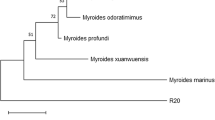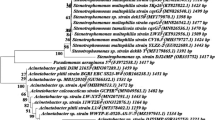Abstract
Zinc solubilizing rhizobacteria (ZSR) enhance the phyto-availability of Zn by converting its insoluble forms into usable forms that are essential for the growth and nutritional quality of crops. In the present study, a potential ZSR, hereafter referred to as strain N14, was isolated from the polyhouse rhizospheric soil of Punjab, India. The isolated rhizobacteria was found to be Gram-positive, aerobic, rod-shaped, and demonstrated a solubilization index of 63.75 on the Bunt Rovira (BR) medium. The 16S rRNA gene sequence analysis revealed that isolated strain N14 matches substantially with type strain Dietzia maris DSM 43672 T. In its ZnO broth assay, a significant amount of soluble Zn was detected along with a simultaneous decrease in pH of the broth. Ultra-performance liquid chromatography analysis revealed the release of organic acids, specifically, lactic acid and acetic acid by D. maris strain N14 which could be the reason for the decrease in broth pH. The production of indole acetic acid (29.91 µg/ml), gibberellic acid (4.72 µg/ml), ammonia (38.87 µg/ml), siderophore (0.89%), along with the release of HCN and appearance of phosphate solubilization zone (14.4 mm) with this strain suggested its possible plant growth-promoting (PGP) characteristics. Therefore, this strain was employed in the formulation of pellets which were applied for in vivo PGP studies using tomato plants. The developed bioformulated pellets showed a significant enhancement in plant growth as compared to control and vermicompost treated plants. To the best of our knowledge, this is the first report describing the Zn solubilizing and PGP characteristics of D. maris.





Similar content being viewed by others
Data Availability
The sequencing data of Dietzia maris strain N14 was deposited in NCBI with GenBank accession no. MZ191749.
Code Availability
Not applicable.
References
Tavallali V, Rahemi M, Eshghi S et al (2010) Zinc alleviates salt stress and increases antioxidant enzyme activity in the leaves of pistachio (Pistacia vera L. ’Badami’) seedlings. Turkish J Agric For 34:349–359. https://doi.org/10.3906/tar-0905-10
Rani N, Kaur R, Kaur S (2020) Zinc solubilizing bacteria to augment soil fertility-a comprehensive review. Int J Agric Sci Vet Med 8:38–44
Gontia-Mishra I, Sapre S, Tiwari S (2017) Zinc solubilizing bacteria from the rhizosphere of rice as prospective modulator of zinc biofortification in rice. Rhizosphere 3:185–190. https://doi.org/10.1016/j.rhisph.2017.04.013
Kalam S, Basu A, Podile AR (2020) Functional and molecular characterization of plant growth promoting Bacillus isolates from tomato rhizosphere. Heliyon 6:e04734. https://doi.org/10.1016/j.heliyon.2020.e04734
Kushwaha P, Srivastava R, Pandiyan K et al (2021) Enhancement in Plant Growth and zinc biofortification of chickpea (Cicer arietinum L.) by Bacillus altitudinis. J Soil Sci Plant Nutr 21:922–935. https://doi.org/10.1007/s42729-021-00411-5
Dinesh R, Srinivasan V, Hamza S et al (2018) Isolation and characterization of potential Zn solubilizing bacteria from soil and its effects on soil Zn release rates, soil available Zn and plant Zn content. Geoderma 321:173–186. https://doi.org/10.1016/j.geoderma.2018.02.013
Bhakat K, Chakraborty A, Islam E (2021) Characterization of zinc solubilization potential of arsenic tolerant Burkholderia spp. isolated from rice rhizospheric soil. World J Microbiol Biotechnol 37:1–13. https://doi.org/10.1007/s11274-021-03003-8
Rainey FA, Klatte S, Kroppenstedt RM, Stackebrandt E (1995) Dietzia, new genus including Dietzia maris comb. nov., formerly Rhodococcus maris. Int J Syst Bacteriol 45:32–36. https://doi.org/10.1099/00207713-45-1-32
Koerner RJ, Goodfellow M, Jones AL (2009) The genus Dietzia: a new home for some known and emerging opportunist pathogens. FEMS Immunol Med Microbiol 55:296–305. https://doi.org/10.1111/j.1574-695X.2008.00513.x
Kämpfer P, Falsen E, Frischmann A, Busse HJ (2012) Dietzia aurantiaca sp. nov., isolated from a human clinical specimen. Int J Syst Evol Microbiol 62:484–488. https://doi.org/10.1099/ijs.0.032557-0
Cappuccino JG, Sherman N (1992) Microbiology; A Laboratory Manual, 3rd edn. Rockland Community College, NY
Bunt JS, Rovira AD (1955) Microbiological studies of some subantarctic soils. J Soil Sci 6:119–128. https://doi.org/10.1111/j.1365-2389.1955.tb00836.x
Yasmin R, Hussain S, Rasool MH et al (2021) Isolation, Characterization of Zn solubilizing bacterium (Pseudomonas protegens RY2) and its Contribution in growth of chickpea (Cicer arietinum L) as deciphered by improved growth parameters and Zn content. Dose-Response 19:1–12. https://doi.org/10.1177/15593258211036791
Shao J, Xu Z, Zhang N et al (2015) Contribution of indole-3-acetic acid in the plant growth promotion by the rhizospheric strain Bacillus amyloliquefaciens SQR9. Biol Fertil Soils 51:321–330. https://doi.org/10.1007/s00374-014-0978-8
Palaniappan P, Chauhan PS, Saravanan VS et al (2010) Isolation and characterization of plant growth promoting endophytic bacterial isolates from root nodule of Lespedeza sp. Biol Fertil Soils 46:807–816. https://doi.org/10.1007/s00374-010-0485-5
Borrow A, Brian PW, Chester VE et al (1955) Gibberellic acid, a metabolic product of the fungus Gibberella fujikuroi: some observations on its production and isolation. J Sci Food Agric 6:340–348. https://doi.org/10.1002/jsfa.2740060609
Schwyn B, Neilands JB (1987) Universal chemical assay for the detection and determination of siderophores. Anal Biochem 160:47–56. https://doi.org/10.1016/0003-2697(87)90612-9
RI P, (1948) Mobilization of phosphorus in soil in connection with vital activity of some microbial species. Mikrobiologiya 17:362–370
Hu X, Chen J, Guo J (2006) Two phosphate- and potassium-solubilizing bacteria isolated from Tianmu Mountain, Zhejiang, China. World J Microbiol Biotechnol 22:983–990. https://doi.org/10.1007/s11274-006-9144-2
HL J, (1942) Nitrogen fixation in leguminous plants. II. Is symbiotic nitrogen fixation influenced by Azotobacter? Pro Line Soc 67:205–212
Kamran S, Shahid I, Baig DN et al (2017) Contribution of zinc solubilizing bacteria in growth promotion and zinc content of wheat. Front Microbiol. https://doi.org/10.3389/fmicb.2017.02593
Russell FM, Biribo SSN, Selvaraj G et al (2006) As a bacterial culture medium, citrated sheep blood agar is a practical alternative to citrated human blood agar in laboratories of developing countries. J Clin Microbiol 44:3346–3351. https://doi.org/10.1128/JCM.02631-05
Schoebitz M, Simonin H, Poncelet D (2012) Starch filler and osmoprotectants improve the survival of rhizobacteria in dried alginate beads. J Microencapsul 29:532–538. https://doi.org/10.3109/02652048.2012.665090
Tamura K, Stecher G, Kumar S (2021) MEGA11: molecular evolutionary genetics analysis version 11. Mol Biol Evol 38:3022–3027. https://doi.org/10.1093/molbev/msab120
Li J, Zhao GZ, Zhang YQ et al (2008) Dietzia schimae sp. nov. and Dietzia cercidiphylli sp. nov., from surface-sterilized plant tissues. Int J Syst Evol Microbiol 58:2549–2554. https://doi.org/10.1099/ijs.0.2008/000919-0
Gharibzahedi SMT, Razavi SH, Mousavi SM (2014) Characterization of bacteria of the genus Dietzia: an updated review. Ann Microbiol 64:1–11. https://doi.org/10.1007/s13213-013-0603-3
Venil CK, Malathi M, Devi PR (2021) Characterization of Dietzia maris AURCCBT01 from oil-contaminated soil for biodegradation of crude oil. 3 Biotech 11:1–13. https://doi.org/10.1007/s13205-021-02807-7
Karnwal A, Dohroo A (2018) Effect of maize root exudates on indole-3-acetic acid production by rice endophytic bacteria under influence of L-tryptophan. F1000Research 7:1–11. https://doi.org/10.12688/f1000research.13644.1
Sunithakumari K, Padma Devi SN, Vasandha S (2016) Zinc solubilizing bacterial isolates from the agricultural fields of Coimbatore, Tamil Nadu, India. Curr Sci 110:196–205. https://doi.org/10.18520/cs/v110/i2/196-205
Costerousse B, Schönholzer-Mauclaire L, Frossard E, Thonar C (2018) Identification of heterotrophic zinc mobilization processes among bacterial strains isolated from wheat rhizosphere (Triticum aestivum L.). Appl Environ Microbiol. https://doi.org/10.1128/AEM.01715-17
Bapiri A, Asgharzadesh A, Mujallali H et al (2012) Evaluation of Zinc solubilization potential by different strains of fluorescent pseudomonads. J Appl Sci Environ Manag 16:295–298
Gandhi A, Muralidharan G (2016) Assessment of zinc solubilizing potentiality of Acinetobacter sp. isolated from rice rhizosphere. Eur J Soil Biol 76:1–8. https://doi.org/10.1016/j.ejsobi.2016.06.006
Mumtaz MZ, Ahmad M, Jamil M, Hussain T (2017) Zinc solubilizing Bacillus spp. potential candidates for biofortification in maize. Microbiol Res 202:51–60. https://doi.org/10.1016/j.micres.2017.06.001
Saravanan VS, Kalaiarasan P, Madhaiyan M, Thangaraju M (2007) Solubilization of insoluble zinc compounds by Gluconacetobacter diazotrophicus and the detrimental action of zinc ion (Zn2+) and zinc chelates on root knot nematode Meloidogyne incognita. Lett Appl Microbiol 44:235–241. https://doi.org/10.1111/j.1472-765X.2006.02079.x
Upadhyay H, Gangola S, Sharma A et al (2021) Contribution of zinc solubilizing bacterial isolates on enhanced zinc uptake and growth promotion of maize (Zea mays L.). Folia Microbiol (Praha) 66:543–553. https://doi.org/10.1007/s12223-021-00863-3
Bhatt K, Maheshwari DK (2020) Zinc solubilizing bacteria (Bacillus megaterium) with multifarious plant growth promoting activities alleviates growth in Capsicum annuum L. 3 Biotech. https://doi.org/10.1007/s13205-019-2033-9
Karnwal A (2021) Pseudomonas spp., a zinc-solubilizing vermicompost bacteria with plant growth-promoting activity moderates zinc biofortification in tomato. Int J Veg Sci 27:398–412. https://doi.org/10.1080/19315260.2020.1812143
Khanghahi MY, Ricciuti P, Allegretta I et al (2018) Solubilization of insoluble zinc compounds by zinc solubilizing bacteria (ZSB) and optimization of their growth conditions. Environ Sci Pollut Res 25:25862–25868. https://doi.org/10.1007/s11356-018-2638-2
Di Simine CD, Sayer JA, Gadd GM (1998) Solubilization of zinc phosphate by a strain of Pseudomonas fluorescens isolated from a forest soil. Biol Fertil Soils 28:87–94. https://doi.org/10.1007/s003740050467
Fasim F, Ahmed N, Parsons R, Gadd GM (2002) Solubilization of zinc salts by a bacterium isolated from the air environment of a tannery. FEMS Microbiol Lett 213:1–6. https://doi.org/10.1016/S0378-1097(02)00725-5
Vidyashree DN, Muthuraju R, Panneerselvam P, Mitra D (2018) Organic acids production by zinc solubilizing bacterial isolates. Int J Curr Microbiol Appl Sci 7:626–633. https://doi.org/10.20546/ijcmas.2018.710.070
Eshaghi E, Nosrati R, Owlia P et al (2019) Zinc solubilization characteristics of efficient siderophore-producing soil bacteria. Iran J Microbiol 11:419–430. https://doi.org/10.18502/ijm.v11i5.1961
Mumtaz MZ, Barry KM, Baker AL et al (2019) Production of lactic and acetic acids by Bacillus sp. ZM20 and Bacillus cereus following exposure to zinc oxide: a possible mechanism for Zn solubilization. Rhizosphere 12:100170. https://doi.org/10.1016/j.rhisph.2019.100170
Fahsi N, Mahdi I, Mesfioui A et al (2021) Plant growth-promoting rhizobacteria isolated from the jujube (Ziziphus lotus) plant enhance wheat growth, zn uptake, and heavy metal tolerance. Agriculture. https://doi.org/10.3390/agriculture11040316
Farokh RZ, Sachdev D, Pour NK et al (2011) Characterization of plant-growth-promoting traits of Acinetobacter species isolated from rhizosphere of Pennisetum glaucum. J Microbiol Biotechnol 21:556–566. https://doi.org/10.4014/jmb.1012.12006
Mumtaz MZ, Ahmad M, Jamil M et al (2018) Bacillus strains as potential alternate for zinc biofortification of maize grains. Int J Agric Biol 20:1779–1786. https://doi.org/10.17957/IJAB/15.0690
Malik DK, Sindhu SS (2011) Production of indole acetic acid by Pseudomonas sp.: effect of coinoculation with Mesorhizobium sp. Cicer on nodulation and plant growth of chickpea (Cicer arietinum). Physiol Mol Biol Plants 17:25–32. https://doi.org/10.1007/s12298-010-0041-7
Gusain P, Paliwal R, Singh V (2017) Rhizoremediation of cadmium-contaminated soil associated with hydroxamate siderophores isolated from Cd-resistant plant growth–promoting Dietzia maris and Lysinibacillus strains. Int J Phytoremediation 19:290–299. https://doi.org/10.1080/15226514.2016.1225281
Acknowledgements
All authors acknowledge the support of the Center of Innovative and Applied Bioprocessing, Mohali, India for providing access to Ultra-performance liquid chromatography (UPLC). All the authors are thankful to Chandigarh University for providing financial support, lab, and other infrastructure.
Funding
The study was carried out using the internal funds of Chandigarh University.
Author information
Authors and Affiliations
Contributions
The research proposal was designed by SK. NR performed the experimental work. Data collection, analysis, and paper writing were done by NR and GK. The UPLC analysis and its interpretation was done by NP. VM contributed in preparing high-resolution figures and the final editing of the manuscript. All authors read and approved the final manuscript.
Corresponding author
Ethics declarations
Conflict of interest
The authors declare no conflicts of interest.
Ethical Approval
The research was approved by the Departmental Research Committee.
Consent to Participations
Not applicable.
Consent for Publications
Not applicable.
Additional information
Publisher's Note
Springer Nature remains neutral with regard to jurisdictional claims in published maps and institutional affiliations.
Supplementary Information
Below is the link to the electronic supplementary material.
Rights and permissions
Springer Nature or its licensor (e.g. a society or other partner) holds exclusive rights to this article under a publishing agreement with the author(s) or other rightsholder(s); author self-archiving of the accepted manuscript version of this article is solely governed by the terms of such publishing agreement and applicable law.
About this article
Cite this article
Rani, N., Kaur, G., Kaur, S. et al. Plant Growth-Promoting Attributes of Zinc Solubilizing Dietzia maris Isolated from Polyhouse Rhizospheric Soil of Punjab. Curr Microbiol 80, 48 (2023). https://doi.org/10.1007/s00284-022-03147-2
Received:
Accepted:
Published:
DOI: https://doi.org/10.1007/s00284-022-03147-2




